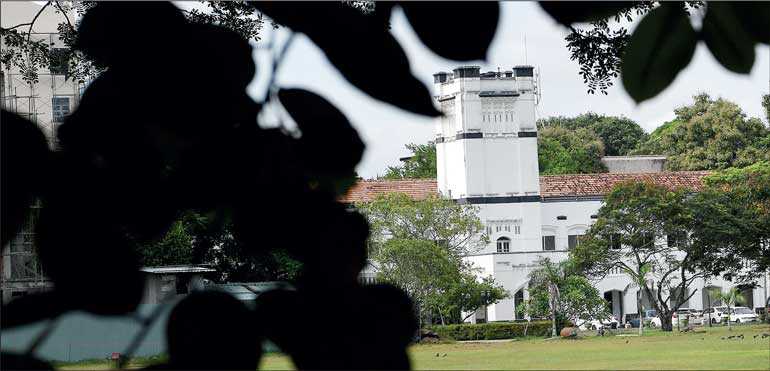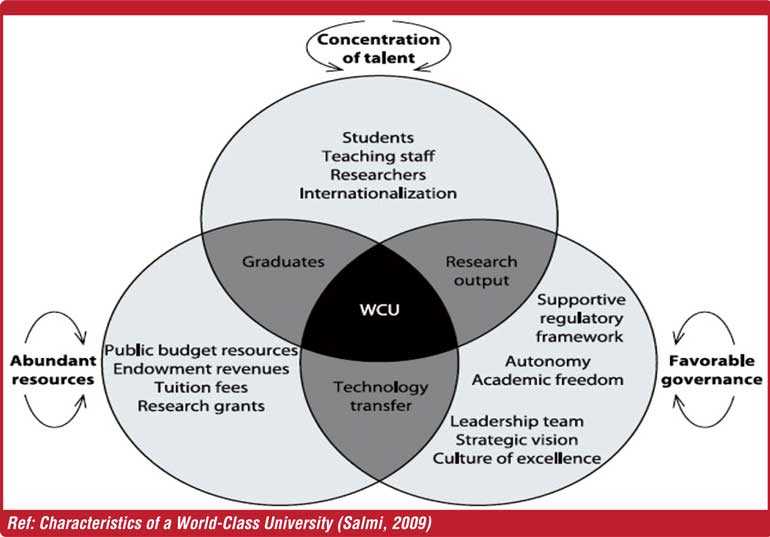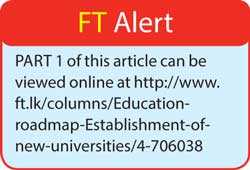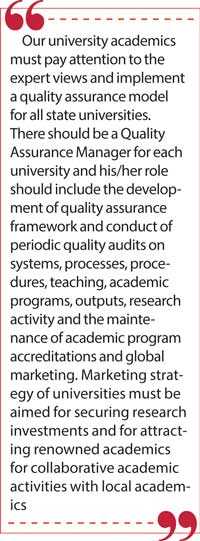Sunday Apr 13, 2025
Sunday Apr 13, 2025
Friday, 9 October 2020 00:00 - - {{hitsCtrl.values.hits}}

The aim of the university system is not to produce zero-defect graduates. Its aim is to produce graduates having high impact strengths and low impact weaknesses – Pic by Shehan Gunasekara

Quantity and Quality dilemma
It is a natural phenomenon when quantity is increased the maintenance of quality becomes harder and harder. However, I would not say, it is impossible. Quality is a broader concept and applied in many areas such as production, construction, manufacturing and many more management areas. 
When I learnt quality management, quality systems, quality analyses, ISO 9001 at post-graduate level, I thought quality control and quality assurance could be easily implemented at a workplace if I have a plan. However, when I started working for the first-ever Australian Local Government City Council which got ISO 9001 and ISO 14000 accreditation, I realised that it was a journey, not a project. Even after two decades, I am still following that journey and the destination is a moving target.
In a university educational environment, this is a much harder job. Externally, universities are showcases of modern buildings with educational, research, library, accommodation, public, entertainment, sporting facilities and a pleasing open space. Internally, we have a group of administrators, facility managers and eminent academics who deliver academic programs. Of course, the essential ingredient are the students.
However, this is not a manufacturing production line. There is nothing called “a perfect human”. Hence, the input raw materials in the university system, the students, have defects. Academics are not defect-free either. The education expert, Watty1, said that the quality dimension “Perfection” which is “Zero Defects”, used in product manufacturing industry should not be used for defining quality of higher education.
Hence, the aim of the university system is not to produce zero-defect graduates. Its aim is to produce graduates having high impact strengths and low impact weaknesses. When the graduates are employed by the wrong industry employers, such weaknesses are exposed. The role of the academics is to challenge the minds of students to sharpen their strengths by showing them development paths to suit to their own capabilities. It is a facilitation process, not a teaching process to encourage rote learning. Universities should be ‘Think Tanks’ encouraging students to be innovative. Therefore, the graduates come out from a university, following the same course will be different to each other, having a range of own defects and own strengths to select own career paths.
The inherent human complexities force the educational experts to look at the quality in higher education in different perspectives.
One school of thought is the attachment of quality to a context (Baird2). Here, we do not talk about quality of education holistically. It is about contextual elements such as quality of teaching, quality of learning, quality of assessment, quality of student screening process etc.
The other school of thought is to look at the quality in terms of the stakeholder point of view. Experts such as Vroeijenstijn3, Middlehurst4 and Harvey and Green5 have highlighted this aspect. Industry and service sector stakeholders would specify certain quality requirements for graduates to suit their needs and accordingly test the graduates at interviews on such qualities. Everybody knows what quality looks like, but no one is certain how to transform a student to achieve such qualities. Harvey and Green5 listed five categories of quality, exceptional, perfect, fitness for purpose, value for money and  transformation. Many experts debated on these categories to identify which categories are relevant to higher education. As mentioned above, Watty1 removed “perfect” from the list as the humans are imperfect. Only perfect raw materials can produce such defect-free outputs. Lomas6 determined “Fitness for Purpose” which is the stakeholder specified quality and the “Transformation” which is about enhancing and empowering the students through teaching and learning programs were the most appropriate for the higher education sector.
transformation. Many experts debated on these categories to identify which categories are relevant to higher education. As mentioned above, Watty1 removed “perfect” from the list as the humans are imperfect. Only perfect raw materials can produce such defect-free outputs. Lomas6 determined “Fitness for Purpose” which is the stakeholder specified quality and the “Transformation” which is about enhancing and empowering the students through teaching and learning programs were the most appropriate for the higher education sector.
Do our university education systems have these quality attributions?
Quality assurance framework
University Grant Commission has a quality assurance council and a brief framework. It specifies the using of a series of Codes of Practice developed for university subjects. As I am a professional civil engineer, I read the Code of Practice for Civil Engineering. I was happy to see that it had a lot of quality elements local employers would seek from an engineering graduate. My personal view is that it is at basic level and needs some work to raise it to the international level.
Further, a code of practice has to be updated yearly basis to bridge the ever-increasing quality  demands of the industry. Also having a code of practice does not mean that the academics will follow it unless UGC enforces it legally. Then, periodic independent assessment of the quality of course material, teaching, leaning outcomes, etc. must be carried out to verify the application of Code of Practice.
demands of the industry. Also having a code of practice does not mean that the academics will follow it unless UGC enforces it legally. Then, periodic independent assessment of the quality of course material, teaching, leaning outcomes, etc. must be carried out to verify the application of Code of Practice.
Until the use of a Code of Practice or a Standard is enforced through a legal document, no one could be found at fault, if COP is not followed. As an example, in Australia, there is a legal document called “National Construction Code” which enforces the use of various Australian Standards for the Design and Construction of structures by the designers and builders. Non-compliance to NCC is punishable offence. If NCC was not available, Australian Standards are just toothless documents and only worth as best practice guides.
Every university must have a quality assurance framework. It is an application of monitoring, review and evaluation process of teaching, learning and research process to ensure outcomes meet the set standards. This framework enables the assessment of the inputs such as entry standards and staff qualifications and competencies, the assessment of processes such as enrolment cycle time, time frame for academic assessments, the assessment of outputs such as graduation completion and the assessment of outcomes such as knowledge and skills acquired by graduates7.
In Australia, the Commonwealth Government and each university pay high attention to the quality assurance of higher education. Almost 30 years ago, in 1992, the Committee for Quality Assurance in Higher Education (CQAHE) was established as a non-statutory Ministerial advisory committee to assist the Australian Commonwealth Government, to implement quality assurance strategy for ensuring the quality, excellence and international standing of Australia’s higher education system. One could see the positive results of this effort by witnessing today that 12 Australian universities are in the top 200 of recent Times Higher Education World University Rankings.
UGC should develop internationally appealing quality assurance framework, enhance all codes of practice to international level and legislate the application of COPs as a mandatory activity of university academic administration process.
Accreditation
It is important that all University Study Courses and Codes of Practices are evaluated by global professional bodies of respective subject areas like engineering, architecture, accounting, management, etc. for accreditation purposes. Such an action will raise our university courses to international level. In my previous article, I have outlined how Sri Lankan engineering degrees were subjected to the accreditation process for the acceptance under the Washington Agreement, following a 25-year arduous journey. In this accreditation process, the professional associations have the responsibility to inform the university what should be done to achieve the accreditation if assessment outcome is unacceptable for offering accreditation.
Recently, I read a Daily FT article criticising the role of Sri Lankan Engineering Council due to non-recognition of some of the engineering degree courses delivered by Sri Lankan private universities. My personal view is that the solution to this issue remains with the university authorities. They should demand specific information from the Institution of Engineers, Sri Lanka where the quality gap exists and what should be done to bridge the gap. Then, the private university authorities could implement the remedial actions. Punishing students for the fault of university authorities is unacceptable. This is where independent assessment is relevant and required. It is not a wise move to demand Engineering Council to accept any degree course without improving the quality of the degree course. Same methodology must be followed for fulfilling and acceptance of professional experience component of the accreditation process.
It is also important to note that everyone who follows a study course at a vocational training centre, a technical college, a private university or a state university in a particular professional career discipline must be informed of the alternative pathways to get the professional memberships of accreditation bodies at the end of the study path, irrespective of the degree of difficulty and the length of the path. Having learning opportunities and having pathways to reach a common study and professional destination like the rest, is a birth right of every citizen. A government should facilitate this kind of educational environment.
Attributes to a world class university
The Sri Lankan educational authorities must aim at establishing world class universities by obtaining necessary technical support from reputed universities in the world. This task is with the academics rather than with the politicians. If the academics know how a world class university looks like, then, they can seek specific assistance.
Why do we have to think in terms of global context rather than local?
It is because the reputation of universities has spread beyond sovereign borders of countries. The quality of outputs from universities are judged by the stakeholders residing beyond borders of countries. So, it makes sense to think globally and act locally.
Experts have varied views on attributes of world class universities. Simmons8 presented a series of adhering principles for universities. It includes having ‘a mission and vision aligned with local societal goals and the focus on academic rigour coupled with peer review and knowledge generation’. Simmons8 added a continuous improvement element as the third principle suggesting the university must be progressive, future facing, nurturing democracy to become a fostering culture of free ideas and academic freedom. Salmi9 suggested three complementary aspects viz; a high concentration of talent, abundant resources and favourable governance.
Knowledge outsourcing
The government will have a difficult job to find qualified, experienced staff for new faculties of state universities and for new universities. So, this must be resolved through innovative applications in short-term. One professor could deliver same lecture through online portal, on large digital screens in each university same time. Also, the Government can invite Sri Lankan overseas university professors to develop international quality course material and share with Sri Lankan academics. Maybe they will agree to serve as visiting lectures free of charge.
Our university academics must pay attention to the expert views and implement a quality assurance model for all state universities. There should be a Quality Assurance Manager for each university and his/her role should include the development of quality assurance framework and conduct of periodic quality audits on systems, processes, procedures, teaching, academic programs, outputs, research activity and the maintenance of academic program accreditations and global marketing. Marketing strategy of universities must be aimed for securing research investments and for attracting renowned academics for collaborative academic activities with local academics.
There are numerous Sri Lankan born professors attached to various world class universities across the globe. They are eagerly waiting for conducive opportunities to contribute to this continuous improvement journey. It is just a matter of a personalised invitation from the President of Sri Lanka to these experts to serve the motherland.
Establishment of internationally acceptable new universities is a war of winning both the quality and the quantity simultaneously. It is a Sri Lankan people’s expectation that the President could win this war as well.
References:
1Watty K. – When will Academics Learn about Quality? – 2003
2Baird, J.R. – Quality: what should make higher education “higher”? – 1998
3Vroeijenstijn – External Quality Assessment, Servant of Two Masters? – 1992
4Middlehurst – Quality: an organising principle for higher education? – 1992
5Harvey and Green – Defining quality, Assessment and Evaluation in Higher Education – 1993
6Lomas – Does the development of mass education necessarily mean the end of quality? – 2001
7TEQSA – Guidance Notes – Academic Quality Assurance – 2017
8Simmons – Striving for excellence: How to make a world-class university – 2003
9Salmi – The Challenge of Establishing World-Class Universities – 2009
(Eng. Janaka Seneviratne is a Chartered Professional Engineer, a Fellow and an International Professional Engineer of both the Institution of Engineers, Sri Lanka and Australia. He holds two Masters Degrees in Local Government Engineering and in Engineering Management and at present, works for the Australian NSW Local Government Sector. His mission is to share his 32 years of local and overseas experience to inspire Sri Lankan professionals. He is contactable via [email protected].)
Education roadmap: Establishment of new universities : Part I
Discover Kapruka, the leading online shopping platform in Sri Lanka, where you can conveniently send Gifts and Flowers to your loved ones for any event including Valentine ’s Day. Explore a wide range of popular Shopping Categories on Kapruka, including Toys, Groceries, Electronics, Birthday Cakes, Fruits, Chocolates, Flower Bouquets, Clothing, Watches, Lingerie, Gift Sets and Jewellery. Also if you’re interested in selling with Kapruka, Partner Central by Kapruka is the best solution to start with. Moreover, through Kapruka Global Shop, you can also enjoy the convenience of purchasing products from renowned platforms like Amazon and eBay and have them delivered to Sri Lanka.
Discover Kapruka, the leading online shopping platform in Sri Lanka, where you can conveniently send Gifts and Flowers to your loved ones for any event including Valentine ’s Day. Explore a wide range of popular Shopping Categories on Kapruka, including Toys, Groceries, Electronics, Birthday Cakes, Fruits, Chocolates, Flower Bouquets, Clothing, Watches, Lingerie, Gift Sets and Jewellery. Also if you’re interested in selling with Kapruka, Partner Central by Kapruka is the best solution to start with. Moreover, through Kapruka Global Shop, you can also enjoy the convenience of purchasing products from renowned platforms like Amazon and eBay and have them delivered to Sri Lanka.